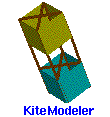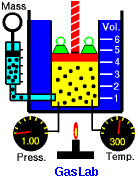
|
Free Software
|
Glenn
Research
Center
|
In an effort to foster hands-on, inquiry-based learning in science and math, the
NASA Glenn Research Center has developed a series of interactive computer programs
for students. All of the programs are Java applets which run in your browser, on-line, over
the World Wide Web.
The programs can also be downloaded to your computer so that you can use them without
being on-line. The programs are in the
public domain and are constantly being modified and
upgraded based on your input.
We would like to know if you are using any of these simulators or
the accompanying Beginner's Guides.
Please notify
Tom Benson, Thomas.J.Benson@nasa.gov,
of any experiences you have with these products. Be sure to include your school name and
e-mail address.
Click on the icon below for more information about the major programs.
 |
FoilSim II:
(80KB)
FoilSim II computes the theoretical lift of a variety of airfoil shapes.
The user can control the shape, size, and inclination of the airfoil and the
atmospheric conditions in which the airfoil is flying.
The program includes a stall model for the airfoil, a model of the Martian
atmosphere, and the ability to specify a variety of fluids for lift comparisons.
The program has graphical and numerical output, including an interactive probe
which you can use to investigate the details of flow around an airfoil.
|
 |
CurveBall:
(39KB) Using the CurveBall
applet, students learn more about aerodynamics by controlling the conditions of
a big league baseball pitch. You can vary the speed of the pitch, the spin on
the ball, the release point, and the location of the stadium which affects the atmospheric
conditions and the amount of curve on the ball. The program will compute balls and strikes
and tells you how far your pitch passes the center of the plate .
|
 |
EngineSim:
( 455KB) EngineSim is a simulator
that models the design and testing of jet engines.
The program works in two modes: Design Mode
or Tunnel Test Mode. In the Design Mode, you can change design variables including
the flight conditions, the engine size, the inlet performance, the turbo machinery
compressor and turbine performance, the combustors or burner performance, or
the nozzle performance. For a turbofan engine design you can also vary the fan
performance and the bypass ratio. When you have a design that you like, you
can switch to the Tunnel Test Mode which simulates the testing of a jet engine
on a test stand. You can then vary the test altitude, flight speed and
throttle setting. Several existing engines are also modeled in EngineSim. |
 |
Undergraduate Computer Programs:
Here is a group of Java programs which were designed to help
undergraduate engineering students learn about the basics of
aerodynamics and propulsion. There are programs to solve for the flows across shock waves
and expansion fans, the flow through crossed and reflected shocks, and
the properties in regions of isentropic flow. There are also special versions
of EngineSim and FoilSim for undergraduates.
|
 |
RangeGames:
(487KB)
This program presents a variety of multiple choice math and physics problems involving aircraft
performance. The student can choose from several different types of aircraft and
must answer questions about the range, fuel usage, acceleration, velocity and
location of the aircraft during take-off.
RangeGames can record your answers for teacher evaluation, or you can just
play for fun.
|
 |
RocketModeler:
This program lets you design and study the flight of a model rocket.
You can vary the size of the rocket, the number of fins, and the
materials used to construct the rocket.
You can choose from a variety of available model rocket engines and test fly
your rocket on the computer. The program computes the stability of your design and
the flight trajectory. Output includes the maximum altitude which the rocket achieves.
You can then compare the computed and actual performance of your model rocket.
|
 |
KiteModeler:
This program lets you design and study the flight of a kite.
You can select from five different types of kites and then vary the
length, width and types of
materials used to construct the kite.
You then trim the kite by setting the length of the bridle and tail and
the position of the knot attaching the control line to the bridle.
Finally, you test fly
your kite on the computer by setting the wind speed and the length of control line.
The program computes the aerodynamic forces, weight, and stability of your design and
the shape of the control line as it sags under its own weight.
Output includes the maximum altitude which the kite achieves.
You can then compare the computed and actual performance of your kite design.
|
 |
Atmosphere Applet:
This program lets you study how pressure, temperature, and density
change through the atmosphere. You can study the atmosphere of the Earth or of Mars.
Since speed of sound depends on the atmospheric gas and the temperature, you can
also output the local speed of sound and the Mach number for a selected aircraft
velocity. You can either input a selected altitude, or change altitude using an
aircraft slider.
|
 |
GasLab Program:
Here is a group of computer animations which were designed to help
high school chemistry students learn about the basics of the gas laws
and the equation of state. The state of a gas is determined by the pressure,
temperature, mass, and volume of the gas. The program lets you fix two of these
variables and observe the relation of the other two variables by changing the
value of one of them.
|
Navigation..





- Beginner's Guide to Aerodynamics
- Beginner's Guide to High Speed Aerodynamics
- Beginner's Guide to Propulsion
- Beginner's Guide to Model Rockets
- Beginner's Guide to Kites
- Wind Tunnel Pages
- Beginner's Guide Home Page
- Aeronautics Resources
- NASA Glenn Learning
Technologies Home Page
|
